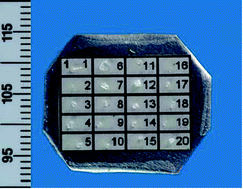The purpose of this study was to develop and validate a method for the forensic analysis of float-glass using laser ablation inductively coupled plasma mass spectrometry (LA-ICP-MS). The study was conducted in two parts. In the first part a procedure was developed and validated for the elemental analysis of float glass by LA-ICP-MS, for the comparison of fragments from a known source with the recovered fragments from a questioned source. The elemental menu comprises 10 elements: potassium (K), titanium (Ti), manganese (Mn), rubidium (Rb), strontium (Sr), zirconium (Zr), barium (Ba), lanthanum (La), cerium (Ce) and lead (Pb). It was shown that the method could be used for glass fragment sizes down to 1 mm2 with LODs in the order of μg g−1 and precision and accuracy <10% for most of the measured elements. In the second part the heterogeneity of some actual float glass panes was measured using the method developed in the first part. Based on these results matching criteria for overlapping of intervals defined by the concentration values ± twice the standard deviation were set for the forensic comparison of float glass samples.

You have access to this article
 Please wait while we load your content...
Something went wrong. Try again?
Please wait while we load your content...
Something went wrong. Try again?


 Please wait while we load your content...
Please wait while we load your content...